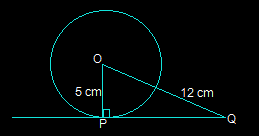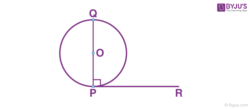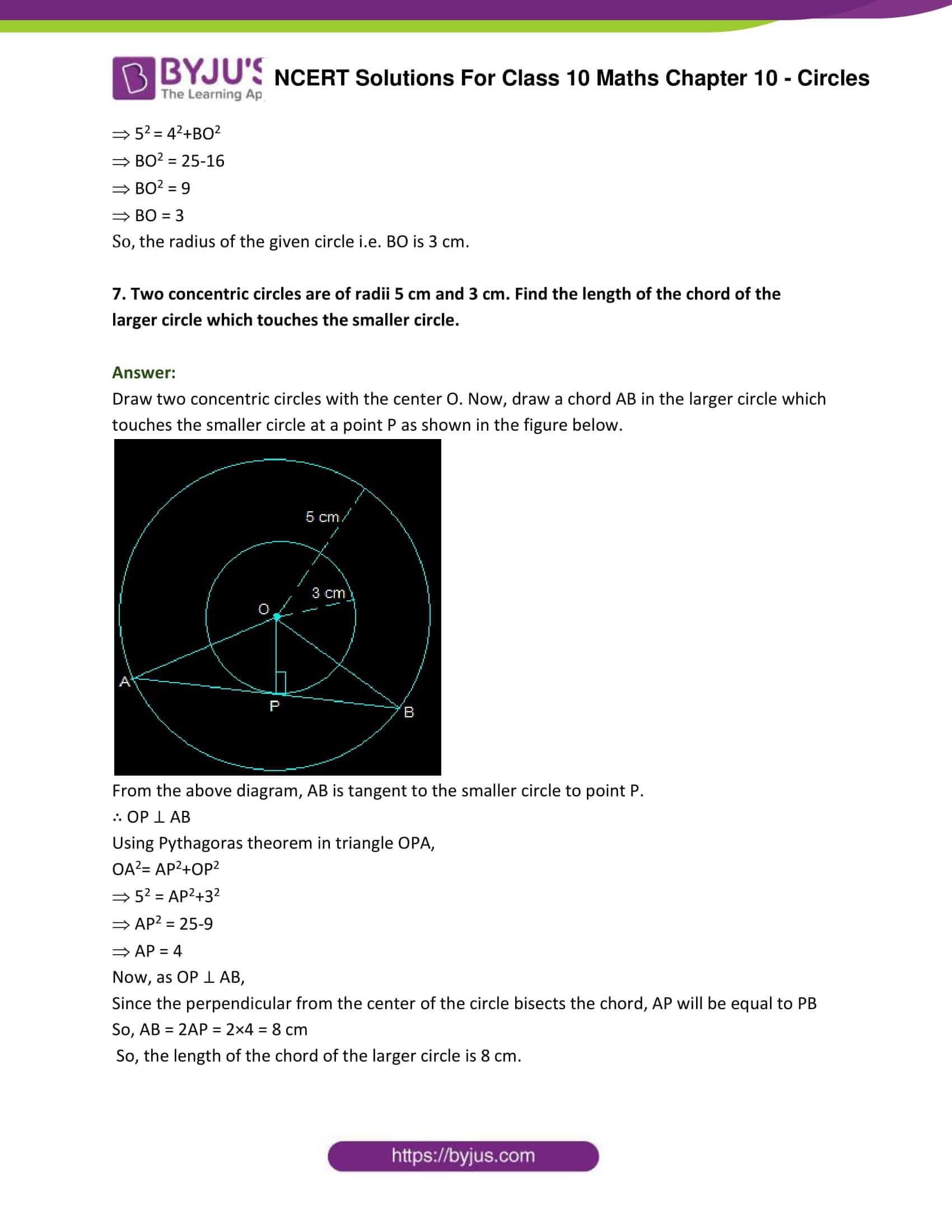NCERT Solutions for Class 10 Maths Chapter 10 – CBSE Term II Free PDF Download
NCERT Solutions for Class 10 Maths Chapter 10 Circles are prepared after thorough research by highly experienced Maths tutors at BYJU’S. This study material, NCERT Solutions for Class 10 Maths is very important for your Class 10 second term exam preparations. We have provided step by step answers to all the questions provided in the NCERT Class 10 Maths textbook.
The NCERT Solutions for Class 10 Maths is free to download and the questions are systematically arranged in an exercise-wise manner for your ease of preparation and in solving different types of questions. In order to score high marks, students are advised to refer to these NCERT Solutions during their preparations.
Download PDF of NCERT Solutions for Class 10 Maths Chapter 10-Circles
Access Answers of NCERT Class 10 Maths Chapter 10 – Circles
Exercise: 10.1 (Page No: 209)
1. How many tangents can a circle have?
Answer:
There can be infinite tangents to a circle. A circle is made up of infinite points which are at an equal distance from a point. Since there are infinite points on the circumference of a circle, infinite tangents can be drawn from them.
2. Fill in the blanks:
(i) A tangent to a circle intersects it in …………… point(s).
(ii) A line intersecting a circle in two points is called a ………….
(iii) A circle can have …………… parallel tangents at the most.
(iv) The common point of a tangent to a circle and the circle is called …………
Answer:
(i) A tangent to a circle intersects it in one point(s).
(ii) A line intersecting a circle in two points is called a secant.
(iii) A circle can have two parallel tangents at the most.
(iv) The common point of a tangent to a circle and the circle is called the point of contact.
3. A tangent PQ at a point P of a circle of radius 5 cm meets a line through the centre O at
a point Q so that OQ = 12 cm. Length PQ is :
(A) 12 cm
(B) 13 cm
(C) 8.5 cm
(D) √119 cm
Answer:

In the above figure, the line that is drawn from the centre of the given circle to the tangent PQ is perpendicular to PQ.
And so, OP ⊥ PQ
Using Pythagoras theorem in triangle ΔOPQ we get,
OQ2 = OP2+PQ2
(12)2 = 52+PQ2
PQ2 = 144-25
PQ2 = 119
PQ = √119 cm
So, option D i.e. √119 cm is the length of PQ.
4. Draw a circle and two lines parallel to a given line such that one is a tangent and the
other, a secant to the circle.
Answer:

In the above figure, XY and AB are two the parallel lines. The line segment AB is the tangent at point C while the line segment XY is the secant.
Exercise: 10.2 (Page NO: 213)
In Q.1 to 3, choose the correct option and give justification.
1. From a point Q, the length of the tangent to a circle is 24 cm and the distance of Q from the centre is 25 cm. The radius of the circle is
(A) 7 cm
(B) 12 cm
(C) 15 cm
(D) 24.5 cm
Answer:
First, draw a perpendicular from the center O of the triangle to a point P on the circle which is touching the tangent. This line will be perpendicular to the tangent of the circle.

So, OP is perpendicular to PQ i.e. OP ⊥ PQ
From the above figure, it is also seen that △OPQ is a right angled triangle.
It is given that
OQ = 25 cm and PQ = 24 cm
By using Pythagoras theorem in △OPQ,
OQ2 = OP2 +PQ2
(25)2 = OP2+(24)2
OP2 = 625-576
OP2 = 49
OP = 7 cm
So, option A i.e. 7 cm is the radius of the given circle.
2. In Fig. 10.11, if TP and TQ are the two tangents to a circle with centre O so that ∠POQ = 110°, then ∠PTQ is equal to
(A) 60°
(B) 70°
(C) 80°
(D) 90°
Answer:
From the question, it is clear that OP is the radius of the circle to the tangent PT and OQ is the radius to the tangents TQ.

So, OP ⊥ PT and TQ ⊥ OQ
∴∠OPT = ∠OQT = 90°
Now, in the quadrilateral POQT, we know that the sum of the interior angles is 360°
So, ∠PTQ+∠POQ+∠OPT+∠OQT = 360°
Now, by putting the respective values we get,
∠PTQ +90°+110°+90° = 360°
∠PTQ = 70°
So, ∠PTQ is 70° which is option B.
3. If tangents PA and PB from a point P to a circle with centre O are inclined to each other at angle of 80°, then ∠ POA is equal to
(A) 50°
(B) 60°
(C) 70°
(D) 80°
Answer:
First, draw the diagram according to the given statement.

Now, in the above diagram, OA is the radius to tangent PA and OB is the radius to tangent PB.
So, OA is perpendicular to PA and OB is perpendicular to PB i.e. OA ⊥ PA and OB ⊥ PB
So, ∠OBP = ∠OAP = 90°
Now, in the quadrilateral AOBP,
The sum of all the interior angles will be 360°
So, ∠AOB+∠OAP+∠OBP+∠APB = 360°
Putting their values, we get,
∠AOB + 260° = 360°
∠AOB = 100°
Now, consider the triangles △OPB and △OPA. Here,
AP = BP (Since the tangents from a point are always equal)
OA = OB (Which are the radii of the circle)
OP = OP (It is the common side)
Now, we can say that triangles OPB and OPA are similar using SSS congruency.
∴△OPB ≅ △OPA
So, ∠POB = ∠POA
∠AOB = ∠POA+∠POB
2 (∠POA) = ∠AOB
By putting the respective values, we get,
=>∠POA = 100°/2 = 50°
As angle ∠POA is 50° option A is the correct option.
4. Prove that the tangents drawn at the ends of a diameter of a circle are parallel.
Answer:
First, draw a circle and connect two points A and B such that AB becomes the diameter of the circle. Now, draw two tangents PQ and RS at points A and B respectively.

Now, both radii i.e. AO and OB are perpendicular to the tangents.
So, OB is perpendicular to RS and OA perpendicular to PQ
So, ∠OAP = ∠OAQ = ∠OBR = ∠OBS = 90°
From the above figure, angles OBR and OAQ are alternate interior angles.
Also, ∠OBR = ∠OAQ and ∠OBS = ∠OAP (Since they are also alternate interior angles)
So, it can be said that line PQ and the line RS will be parallel to each other. (Hence Proved).
5. Prove that the perpendicular at the point of contact to the tangent to a circle passes through the center.
Solution:
Let, O is the centre of the given circle.
A tangent PR has been drawn touching the circle at point P.
Draw QP ⊥ RP at point P, such that point Q lies on the circle.

∠OPR = 90° (radius ⊥ tangent)
Also, ∠QPR = 90° (Given)
∴ ∠OPR = ∠QPR
Now, the above case is possible only when centre O lies on the line QP.
Hence, perpendicular at the point of contact to the tangent to a circle passes through the centre of the circle.
6. The length of a tangent from a point A at distance 5 cm from the centre of the circle is 4 cm. Find the radius of the circle.
Answer:
Draw the diagram as shown below.

Here, AB is the tangent that is drawn on the circle from a point A.
So, the radius OB will be perpendicular to AB i.e. OB ⊥ AB
We know, OA = 5cm and AB = 4 cm
Now, In △ABO,
OA2 =AB2+BO2 (Using Pythagoras theorem)
52 = 42+BO2
BO2 = 25-16
BO2 = 9
BO = 3
So, the radius of the given circle i.e. BO is 3 cm.
7. Two concentric circles are of radii 5 cm and 3 cm. Find the length of the chord of the larger circle which touches the smaller circle.
Answer:
Draw two concentric circles with the center O. Now, draw a chord AB in the larger circle which touches the smaller circle at a point P as shown in the figure below.

From the above diagram, AB is tangent to the smaller circle to point P.
∴ OP ⊥ AB
Using Pythagoras theorem in triangle OPA,
OA2= AP2+OP2
52 = AP2+32
AP2 = 25-9
AP = 4
Now, as OP ⊥ AB,
Since the perpendicular from the center of the circle bisects the chord, AP will be equal to PB
So, AB = 2AP = 2×4 = 8 cm
So, the length of the chord of the larger circle is 8 cm.
8. A quadrilateral ABCD is drawn to circumscribe a circle (see Fig. 10.12). Prove that AB + CD = AD + BC
Answer:
The figure given is:

From this figure we can conclude a few points which are:
(i) DR = DS
(ii) BP = BQ
(iii) AP = AS
(iv) CR = CQ
Since they are tangents on the circle from points D, B, A, and C respectively.
Now, adding the LHS and RHS of the above equations we get,
DR+BP+AP+CR = DS+BQ+AS+CQ
By rearranging them we get,
(DR+CR) + (BP+AP) = (CQ+BQ) + (DS+AS)
By simplifying,
AD+BC= CD+AB
9. In Fig. 10.13, XY and X′Y′ are two parallel tangents to a circle with centre O and another tangent AB with point of contact C intersecting XY at A and X′Y′ at B. Prove that ∠ AOB = 90°.
Answer:
From the figure given in the textbook, join OC. Now, the diagram will be as-

Now the triangles △OPA and △OCA are similar using SSS congruency as:
(i) OP = OC They are the radii of the same circle
(ii) AO = AO It is the common side
(iii) AP = AC These are the tangents from point A
So, △OPA ≅ △OCA
Similarly,
△OQB ≅ △OCB
So,
∠POA = ∠COA … (Equation i)
And, ∠QOB = ∠COB … (Equation ii)
Since the line POQ is a straight line, it can be considered as a diameter of the circle.
So, ∠POA +∠COA +∠COB +∠QOB = 180°
Now, from equations (i) and equation (ii) we get,
2∠COA+2∠COB = 180°
∠COA+∠COB = 90°
∴∠AOB = 90°
10. Prove that the angle between the two tangents drawn from an external point to a circle is supplementary to the angle subtended by the line-segment joining the points of contact at the center.
Answer:
First, draw a circle with centre O. Choose an external point P and draw two tangents PA and PB at point A and point B respectively. Now, join A and B to make AB in a way that it subtends ∠AOB at the center of the circle. The diagram is as follows:

From the above diagram, it is seen that the line segments OA and PA are perpendicular.
So, ∠OAP = 90°
In a similar way, the line segments OB ⊥ PB and so, ∠OBP = 90°
Now, in the quadrilateral OAPB,
∴∠APB+∠OAP +∠PBO +∠BOA = 360° (since the sum of all interior angles will be 360°)
By putting the values we get,
∠APB + 180° + ∠BOA = 360°
So, ∠APB + ∠BOA = 180° (Hence proved).
11. Prove that the parallelogram circumscribing a circle is a rhombus.
Answer:
Consider a parallelogram ABCD which is circumscribing a circle with a center O. Now, since ABCD is a parallelogram, AB = CD and BC = AD.

From the above figure, it is seen that,
(i) DR = DS
(ii) BP = BQ
(iii) CR = CQ
(iv) AP = AS
These are the tangents to the circle at D, B, C, and A respectively.
Adding all these we get,
DR+BP+CR+AP = DS+BQ+CQ+AS
By rearranging them we get,
(BP+AP)+(DR+CR) = (CQ+BQ)+(DS+AS)
Again by rearranging them we get,
AB+CD = BC+AD
Now, since AB = CD and BC = AD, the above equation becomes
2AB = 2BC
∴ AB = BC
Since AB = BC = CD = DA, it can be said that ABCD is a rhombus.
12. A triangle ABC is drawn to circumscribe a circle of radius 4 cm such that the segments BD and DC into which BC is divided by the point of contact D are of lengths 8 cm and 6 cm respectively (see Fig. 10.14). Find the sides AB and AC.
Answer:
The figure given is as follows:

Consider the triangle ABC,
We know that the length of any two tangents which are drawn from the same point to the circle is equal.
So,
(i) CF = CD = 6 cm
(ii) BE = BD = 8 cm
(iii) AE = AF = x
Now, it can be observed that,
(i) AB = EB+AE = 8+x
(ii) CA = CF+FA = 6+x
(iii) BC = DC+BD = 6+8 = 14
Now the semi perimeter “s” will be calculated as follows
2s = AB+CA+BC
By putting the respective values we get,
2s = 28+2x
s = 14+x

By solving this we get,
= √(14+x)48x ……… (i)
Again, the area of △ABC = 2 × area of (△AOF + △COD + △DOB)
= 2×[(½×OF×AF)+(½×CD×OD)+(½×DB×OD)]
= 2×½(4x+24+32) = 56+4x …………..(ii)
Now from (i) and (ii) we get,
√(14+x)48x = 56+4x
Now, square both the sides,
48x(14+x) = (56+4x)2
48x = [4(14+x)]2/(14+x)
48x = 16(14+x)
48x = 224+16x
32x = 224
x = 7 cm
So, AB = 8+x
i.e. AB = 15 cm
And, CA = x+6 =13 cm.
13. Prove that opposite sides of a quadrilateral circumscribing a circle subtend supplementary angles at the centre of the circle.
Answer:
First draw a quadrilateral ABCD which will circumscribe a circle with its centre O in a way that it touches the circle at point P, Q, R, and S. Now, after joining the vertices of ABCD we get the following figure:

Now, consider the triangles OAP and OAS,
AP = AS (They are the tangents from the same point A)
OA = OA (It is the common side)
OP = OS (They are the radii of the circle)
So, by SSS congruency △OAP ≅ △OAS
So, ∠POA = ∠AOS
Which implies that∠1 = ∠8
Similarly, other angles will be,
∠4 = ∠5
∠2 = ∠3
∠6 = ∠7
Now by adding these angles we get,
∠1+∠2+∠3 +∠4 +∠5+∠6+∠7+∠8 = 360°
Now by rearranging,
(∠1+∠8)+(∠2+∠3)+(∠4+∠5)+(∠6+∠7) = 360°
2∠1+2∠2+2∠5+2∠6 = 360°
Taking 2 as common and solving we get,
(∠1+∠2)+(∠5+∠6) = 180°
Thus, ∠AOB+∠COD = 180°
Similarly, it can be proved that ∠BOC+∠DOA = 180°
Therefore, the opposite sides of any quadrilateral which is circumscribing a given circle will subtend supplementary angles at the center of the circle.
| Also Access |
| NCERT Exemplar for class 10 Maths Chapter 10 |
| CBSE Notes for class 10 Maths Chapter 10 |
NCERT Solutions for Class 10 Maths Chapter 10 Circles
Chapter 10 Circles of NCERT Class 10 Maths is included in Unit 4 Geometry of Term II CBSE Syllabus for 2021-22. This unit has a weightage of 22 marks allotted in Class 10 second term examinations. Unit 4 will have 4 MCQs carrying 4 marks, 2 Short answer questions carrying 6 marks and two long answer questions carrying 12 marks. Refer to the Maths NCERT Solutions for Class 10 to attain a grip over solving problems using the concepts of this chapter.
Sub-topics of Class 10 Chapter 10 Circles
- Introduction to Circles
- Tangent to a circle
- Number of Tangents from a point on a circle
- Summary of the Whole Chapter
List of Exercise from Class 10 Maths Chapter 10 Circles
Exercise 10.1– 4 Questions which includes 1 short answer question, 1 fill in the blanks question and 2 long answer questions
Exercise 10.2– 13 Questions which includes 10 long answer questions, 4 descriptive type questions and 2 short answer questions
The NCERT Solutions for Class 10 will guide you to understand the concepts involved in circles. You can refer to this for a better understanding of the concept. This Solution will also aid you to score good marks in the examination.
Class 10 Maths Chapter 10 deals with the existence of the tangents to a circle and some of the properties of a circle. Students are introduced to some complex terms such as tangents, tangents to a circle, number of tangents from a point on the circle. This chapter seems very interesting due to the diagrams and involvement of geometrical calculations.
These NCERT Solutions for Class 10 Maths Chapter 10 has some tricky concept questions on circles that will help you to clear all your doubts when you study. Students are recommended to study these solutions to know alternative calculation methods.
Key Features of NCERT Solutions for Class 10 Maths Chapter 10 Circles
- Provide answers to all the exercise questions in the NCERT class 10 Maths textbook.
- Create a practise of tricky questions which will clear your understanding of the topics.
- Covers the updated term-wise CBSE Syllabus and possible types of questions to be asked in the examination.
- Helps you to practise important drawings.
- Aids you in memorizing important formulas and calculation methods.
BYJU’S provides NCERT Solutions, NCERT Exemplars, notes, textbooks, videos and animations of all the subjects and classes. To get access to the study resource we provide, register with BYJU’S website or download BYJU’S learning App.
At BYJU’S, students can also access other study materials of the CBSE Board to understand the types of questions which are crucial from the exam point of view.

















Comments